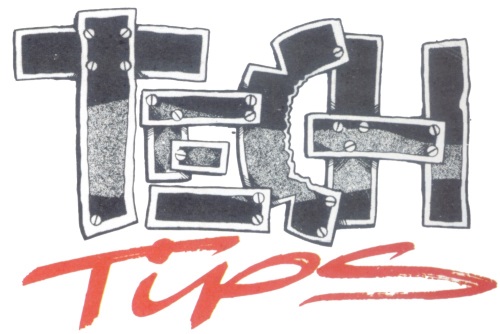

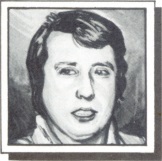
Almost a year since CRASH’s first in-depth look at the SAM, MGT invited the press down to their new Swansea headquarters for a comprehensive briefing and a look at the production prototype. IAN CULL was there and explains why MGT might be onto a winner.
MILES GORDON Technology is a company with a purpose. According to their PR, the company was formed — just two years ago — with the express purpose of developing a high-quality, user entry-level computer. Amstrad’s dismantling of Sinclair Research at that time certainly ended rumours of a Super Spectrum, leaving a gap for an innovative, British computer developer.
MGT, by contrast, have plans to create a whole new series of computers. Much as the ill-fated Enterprise before it, SAM promises superior capabilities and upward compatibility so that you can uprate your base machine, rather than having to throw it away, for additional features. Unlike the Enterprise, SAM is compatible with a large amount of existing Spectrum software (about 80%) and is deliberately starting with a small production run, and high quality control, to avoid Sinclair’s notorious problems.
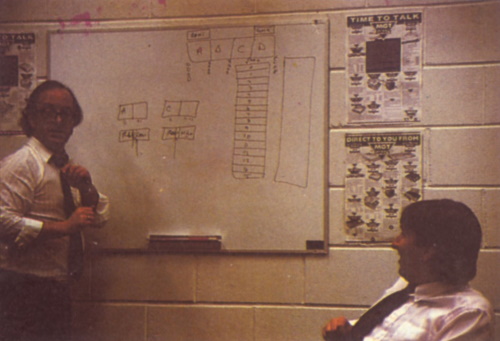
Bruce Gordon explaining memory pages to Alan Miles on the right
To further ensure the machine’s success it has been designed with an eye to education requirements. Both the cheap price and a built-in networking facility mean it should be highly attractive in this area. To keep costs down, and reliability good, the chip count has been kept low. This ease of manufacturing is also useful for licensed production abroad. An Indian manufacturer has already been signed up, not only to produce for the massive Indian market, but for the UK as well.
At first SAM will be available only through MGT’s well-established mail order department, but there are plans to expand into the high street. MGT are aiming for sales of 56,000 in the first year, about half of them in the UK.
‘SAM will positively bristle with interfaces’
Possibly the most interesting aspect of SAM is its use of an 8-bit Z80B processor, when both Atari and Commodore have gone firmly for 16-bit technology. MGT’s reasons for this involve low cost and the long experience software houses have with the Z80. As a result, MGT expect to have a lot of software available at launch. Moreover SAM’s Z80 chip will be running at 6 MHz, compared to 4 Mhz for the Spectrum.
Most of the development work on SAM has revolved around the design of a custom Fujitsu ULA chip. This relatively advanced chip will contain all the circuitry developed using around 130 individual ICs. Production SAMs will thus have just seven chips — Z80B microprocessor, 32K ROM, 256K RAM in two chips, six-channel stereo sound chip, 64-colour TV modulator chip and the ASIC itself. It will also be possible to add an additional 256K RAM and one or two disk drives — these are a new ultra-thin Citizen design, and will mount in the front of the computer under the keyboard!
The basic SAM will positively bristle with interfaces. There’s a standard Sinclair joystick interface, a mouse port, monitor and TV outputs, audio output, MIDI In and Out connectors (the Out can double as Thru), printer (serial or parallel will be supported using an ‘intelligent’ cable), light pen input and cassette. There is also a full expansion connector. On top of that there’s a 71 key keyboard with ‘soft’ key definitions, allowing any key to be a function key beside the 10 function keys available.
At the heart of all this there’s the ROM, written by Dr Andy Wright, the author of Spectrum Beta Basic. Anyone who has used Beta Basic should therefore be assured that the SAM is going to be a ‘good machine’. It will still be a Basic computer, but will have letter-by-letter entry (rather than the 48K Spectrum keyword system). There will also be a built-in Disk Operating System similar to the Plus D DOS, but able to handle random access files.
‘Mode 2 is a ‘Super Spectrum’ screen’
The performance all this hardware offers is pretty impressive. On the sound front the Philips chip has six channels (the Amiga has only four) which can output through headphones or hi-fi, as well as the TV. However, the screen graphics are where the computer will really shine. There are 64 colours available, accessible via the colour look-up table. There are four modes available.
Mode 1 is a Spectrum screen — eight colours with bright and flash, with 8x8 attributes (hence colour clash) on a 256x192 pixel display. However, the eight colours need not be original Spectrum ones — any of the 64 can be selected.
Mode 2 is a ‘Super Spectrum’ screen — the same 256x192 pixels with separate attributes, but having a separate attribute byte for each 8x1 pixels on screen — thus eight times as many different colours can be onscreen at once. This mode also enhances the normal Spectrum display by re-ordering the pixels so that they run sensibly from top to bottom (rather than jumping in thirds as the normal Spectrum does now). Anyone who has tried to write machine code display routines will realise the significance of this.
Mode 3 offers the same 256x192 pixels — but each pixel can be individually set to one of 16 colours, selected from the 64 colour palette. This is the mode that will be used by art programs etc. Since 24K of RAM is needed, it may be too slow for games programs.
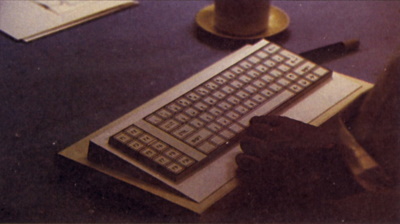
A cardboard mock-up of the designer computer casing
Mode 4 is a text screen, offering 512x192 pixels. Each pixel can be one of four colours, but having 512 pixels across the screen allows a readable 80 character display.
One powerful feature of the screen palette is that it can be altered very quickly. So, using interrupts, it would be possible to change the 16 colours in use by Mode 3 while the screen is being displayed — this would give access to the full 64 colours at once (a similar technique to the Spectrum Rainbow Processor, but easier to implement). The SAM Coupé can even change screen modes part-way down the screen — allowing adventure games to have a very hi-res picture of the location, with 80 column text below for description. It’s also possible to change the location of screen memory by altering a single register (so a number of screens can be instantly displayed).
‘Multitasking would be quite easy and very fast’
The memory paging system is also an innovation (especially when compared with the 128K Spectrum’s system). The Z80 processor can only access 64K of memory — so even with 32K of ROM and up to 512K of RAM, the Coupé can only use 64K, without special hardware. The SAM Coupé architecture splits the Z80 memory map into four 16K blocks — A (memory addresses hex 0000... 3FFF), B, C and D (hex C000... FFFF). The ROM is split into two halves — one can be brought in over block A (holding BASIC code) and one over block D (holding DOS).
There are two 8-bit registers in the hardware, which can be used to select which 16K pages of RAM from the 256K (or 512K on an expanded SAM Coupé) are to be accessible by the Z80. Reglo selects which page is accessible through block A. The hardware automatically makes the next page available through block B. Similarly, Reghi does the same for blocks C and D.
This may sound complex, but gives two major benefits. The first is that a complete, new 64K memory map can be brought in with one machine code instruction, writing to Reglo and Reghi at once (as a 16-bit word). Multitasking (of up to four programs at once) would therefore be quite easy and very fast. The second benefit is that it will be possible to write programs that can use the full available memory! If all memory is accessed via blocks C & D using a memory pointer, then any 32K can be accessed as a normal paging mechanism would bring in the next page — losing the current block D contents. This makes handling information which crosses the boundary very difficult.
The SAM system, however, makes the problem nonexistent. Incrementing the Reghi value will effectively shift the memory in block D down to the block C area, and bring in the next page to block D. Now the pointer can be reduced by 16K (a simple machine code subtraction) and it is then still pointing to the same information (though now at address BFFF). The following page is now available, but so is the previous data.
Another feature of the SAM Coupé is that all the ROM code can be de-selected (giving an all RAM machine) and memory A can be write-protected. This allows a new ROM to be loaded into block A then locked, preventing corruption by rogue programs.
‘Many existing Spectrum games can be loaded in and run without problems’
This brings us to the facility of the SAM Coupé to emulate a Spectrum. The Mode 1 screen already gives the same screen format as the Spectrum. The Coupé also has hardware circuits to emulate the Spectrum BEEP command. By loading in a tape copy of a Spectrum 48K ROM to memory block A, then write protecting it, the result is a computer which behaves very like a 48K ZX Spectrum, but running faster than normal (with the possibility of choosing a new palette of colours, too).
‘Some form of snapshot will be built into SAM’
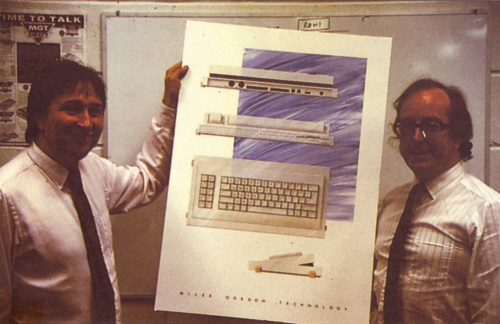
Miles and Gordon with The Nick Holland Design Group’s design
This feature of the SAM Coupé will mean that many existing Spectrum games can be run without problems (the Coupé even emulates the ULA feature used in games like Arkanoid, and omitted by Amstrad in their +3 and +2A). The Coupé will not be able to run 128K games — but its more elegant memory addressing a vastly superior sound may mean the death of the 128K Spectrum in favour of SAM! Miles Gordon Technology are trying very hard to create a new, very customer-orientated computer market. The SAM Coupé can take hardware add-ons in much the same way as the Spectrum does (indeed, some Spectrum add-ons can be used with the Coupé) but a proper edge connector will mean the end of RAM pack wobbles! MGT are also making an expansion frame (reminiscent of the Gordon Microframe) for ‘power users’. In addition MGT will try to control add-on manufacturers so that hardware clashes are avoided — I/O port locations will be allocated to each manufacturer. Some form of snapshot will also be built in, allowing tape-based users upgrading to disk to transfer their games without hassle.
One other point worth making is that, while we have not yet been told what the rest of the SAM series will consist of, MGT assure us there will be an upgrade — no more ‘throwaway’ computers. My suspicion (based on Alan Miles’ comment that the Coupé is taking 8-bit technology ‘as far as it can go') is that a new processor will be used in later models. Perhaps the Coupé will simply be a keyboard, screen and disk interface for some faster processor (much like the old Acorn/BBC tube design...)
As the SAM Coupé comes nearer to being on the market, CRASH will continue to monitor its progress — it is hoped that a pre-production will be available by the end of February. In the meantime expect the delayed Version 2 DICE review and much more besides. Letters pleading for SAMs should be addressed to MGT. Everything else can be sent to Ian Cull, Tech Niche, CRASH. See ya...